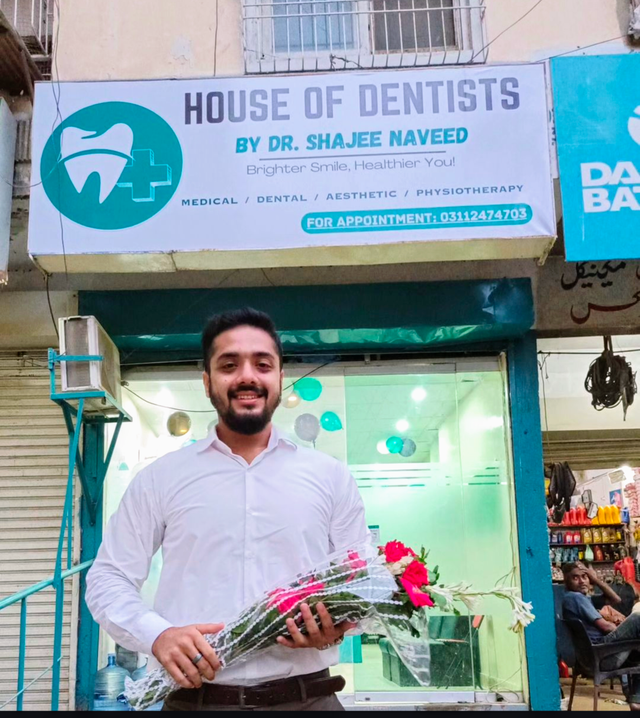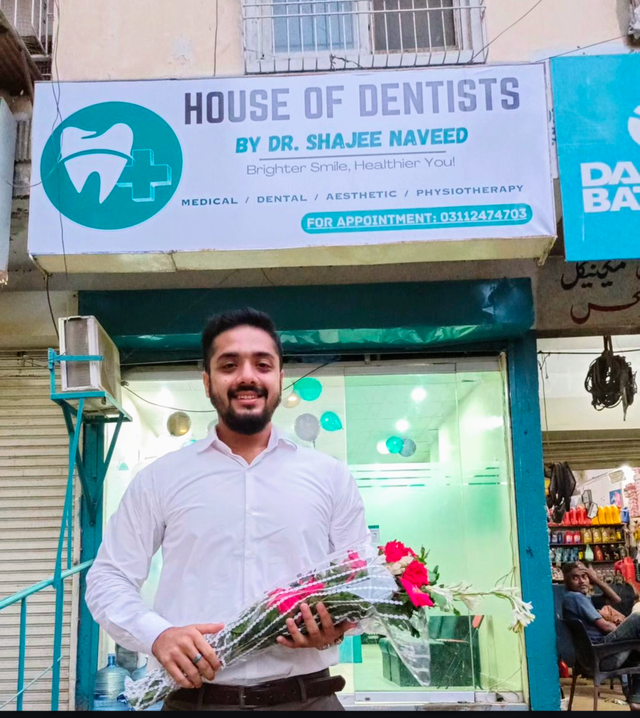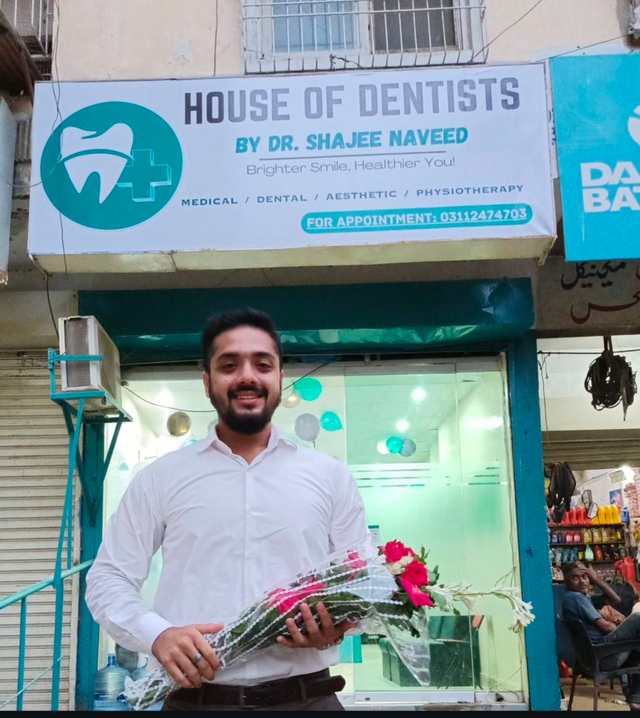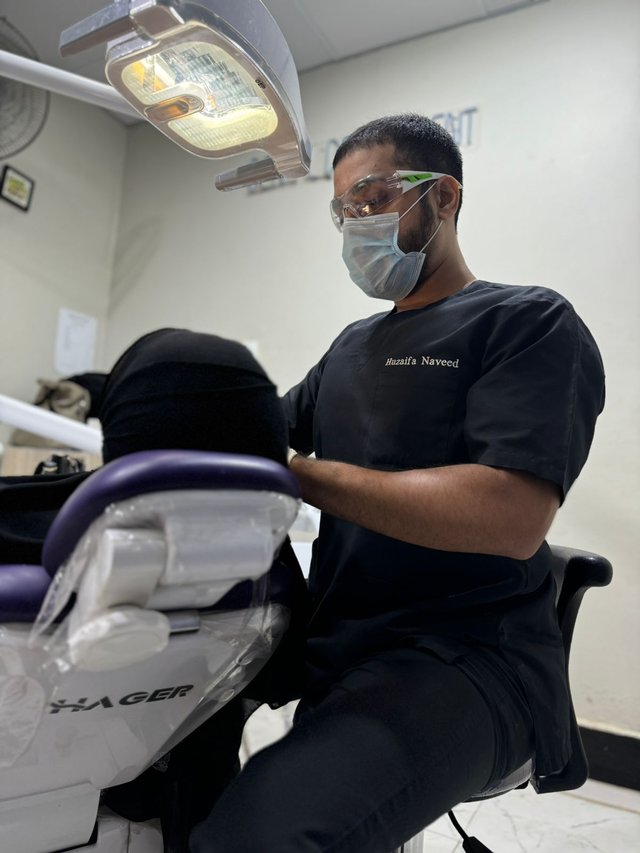
This is a long read but I promise you it'll be worth it. Read it till end, you might learn a thing or two.
Business. The word itself sparks excitement, doesn’t it? Business, revenue, profit, MONEYYY. These terms, especially for those unfamiliar with the field, ignite curiosity and anticipation. Everyone wants to make money. About 95% aim for easy money, but only 5% truly understand what it takes to earn it. That’s why only 5% of people manage to sustain their businesses for decades or centuries, while the remaining 95% enjoy profits only briefly.
I used to be part of that 95% when I first started my ventures. In this post, I’ll walk you through the journey of my startups, my mistakes, how I corrected them, and the lessons life offered at every turn.
Currently, I own two businesses:
- House of Dentists (Dental Clinic)
- Soghaat e Hunza (Honey Supplier)
I’ll discuss both and, in the end, share my advice for aspiring entrepreneurs. Let’s dive in!
Q1. Please tell us about your initial investment value in terms of Steem as well as in US$, and how you manage it.
Firstly I'll be talking about the business I started off completely on my own. I name it:
Soghaat e Hunza |
|---|
It all began with a phone call on June 11th, 2020, during the height of the global COVID-19 pandemic. The world had practically come to a standstill, with lockdowns affecting almost every industry. That day, I received a call from a honey vendor in the northern areas of Pakistan, whom I had met during a recent trip to the mountains. He was clearly distressed, as the usual flow of tourists had come to a complete halt, and with no visitors in the region, his honey wasn’t selling at all.
Desperate for help, he asked if there was any way I could assist him. I reassured him that I would try my best, and asked him to send me 20 kilograms of honey. The cost of those 20 kilograms came to around $60, which was equivalent to about 360 Steem at the time.
Once I received the parcel, I distributed the honey among my friends and family, not thinking much of it at first. About a week later, I started getting multiple calls from everyone who had tasted the honey, asking for more. They were all eager to buy additional quantities.
Recognizing an opportunity, I decided to turn this situation into something more substantial. Being someone with a passion for business, I saw this as the perfect moment to start something bigger—a honey business. That was the day I began laying the foundation for what would become a thriving enterprise: a honey empire.

I informed my relatives that I had officially launched a honey-selling business, and I quoted a price per kilogram that included a small profit margin for myself. Without hesitation, I placed a larger bulk order with the vendor.
And so, the journey began. While it started small, it quickly grew into something meaningful and successful. Of course, it wasn’t without its challenges. I had to navigate through many ups and downs to ensure the business became sustainable. I’ll delve more into the details of my profits and losses in the upcoming sections, but for now, let’s focus on the initial capital required.
| First Consignment | $60 | 360 Steem |
|---|---|---|
| Second Consignment | $120 | 720 Steem |

House of Dentists |
|---|
As a dentist, and coming from a family where my elder brother is also a dentist and the rest of my brothers and parents are doctors, it was always my father's lifelong dream to achieve something he couldn’t—having a clinic or hospital of our own. As his children, we had wanted to fulfill this dream for a long time.
My eldest brother, after becoming a doctor, moved to England at my father's urging. This left my other brother, who is also a dentist, and me to carry on the mission of making our father’s dream a reality.
The journey required a lot of hard work. Opening a dental clinic in Pakistan demands significant capital, careful planning, and considerable courage. With inflation skyrocketing in the country, we had to tread cautiously with every decision.
The most challenging part was finding a suitable location for our clinic. After much searching and planning, we finally made it happen on August 11th, 2024. We secured a rental space, purchased all the necessary and expensive equipment ourselves, and avoided taking any loans from outside the family (I’ll elaborate on this decision in the upcoming sections).
At last, we realized our dream of establishing our very own dental clinic. The initial capital investment required for this project was:
| Initial investment | $7,500 | 46,000 Steem |
|---|


A profit and loss statement is commonly known as a statement that shows details of your business's revenue and expenses over a period that we calculate on a monthly, quarterly, or annual basis. How do you determine whether your business made a profit or loss during a stipulated period?
Apologies for not copying the subparts of this question, but I’m sure my mate @dove11 knows exactly what subquestions I'm referring to here.
Profits and losses—an intriguing topic indeed. Before I dive into the specifics, let me offer my two cents on the word “profit.” Never let yourself get too excited too quickly over profits. If they aren’t managed wisely, profits can disappear as fast as they came.
Let me first discuss the details of my first business:
Soghaat e Hunza |
|---|
My honey business didn’t exactly make me rich overnight, but it felt like it! Of course, there was a tremendous amount of effort and sweat behind my success. There were times when I was making as much as $1,000 in profit per month. However, as I mentioned earlier, if you don’t manage your profits well, they can vanish in no time.
I didn’t keep track of my profits the way I should have. The work, the money, the effort, and the adrenaline of working tirelessly for my own business gave me an intense rush of energy every day. It was like I was a slave to my own ambition, constantly driven to push further. I had a plan in mind for reinvesting my profits into the business, and while I did stick to that to some extent, it just wasn’t enough.
In the first six months, I was able to expand my business significantly, and within a year, I became somewhat of a local sensation. Everyone in town knew that Huzaifa was the CEO of Soghaat e Hunza, and word quickly spread that I was making a lot of money. But with fame and fortune came overconfidence. I began hiring more staff without properly managing the financial side of the business.
The auditing was a complete mess. I rarely took the time to audit my budget, track my revenue, or calculate my profits accurately. Over the course of two years, my once-thriving business started experiencing losses.
Although I made a considerable amount in those first six months, poor management and inadequate budget planning led to the rapid depletion of my profits. This is why I now emphasize the importance of sustainability in business. Starting a business is easy, and making money might seem simple at first. But the real challenge lies in maintaining and sustaining that business over time.
By 2022, when reality hit me, I decided to restart everything from scratch. I reevaluated my budget allocation, marketing strategy, staffing, inventory, and essentially rebuilt the entire business.
Im order to make my business flourish again I opted for a 70:30 rule.
70:30 Rule |
|---|
For me, the 70:30 rule is a crucial part of managing my business finances. The way I apply it is by taking 70% of the profit I make each month and reinvesting it back into the business. This 70% is then further divided into several essential areas to keep the business running smoothly. It covers the cost of:
- Inventory management
- Staff salaries
- Marketing agency fees
- Transportation costs
- Miscellaneous expenses
By reinvesting in these key areas, I ensure that the business continues to grow and sustain itself.
The remaining 30% of the profit comes to me personally. However, even this portion is divided using the 70:30 rule. I place 70% of the personal profit, which is about 21% of the total profit, into a savings account to secure my financial future. The remaining 30%, or roughly 9% of the total profit, is what I allow myself to spend on personal needs and leisure activities. Out of this 9%, I cover my basic necessities while also enjoying some money for myself each month.
Currently, my honey products are available in several major supermarkets across Karachi, and we offer delivery services throughout Pakistan. I also have a small team of employees working under me. Over time, I’ve learned valuable lessons, and I hope you can avoid the mistakes I made by learning from my experiences.

House of Dentists |
|---|
Running a successful dental clinic was vastly different from managing a honey business. The most obvious difference was the significantly higher initial investment. Opening the dental clinic alone cost us around $7,500, which was just the beginning. After that, we had to account for ongoing maintenance costs, staff salaries, equipment purchases, rent, and various unexpected expenses that seemed to arise constantly. We also had to cover the costs of generator fuel and electricity bills, all of which added up quickly. This level of financial commitment required a thoroughly thought-out, solid plan. We couldn’t afford to be careless, so we ensured that every aspect was meticulously planned and executed. Curious about how we made it happen? Let’s dive into the details.
Running a successful dental clinic |
|---|
The first step to running a successful business is to truly take ownership of it. Nurture it, give it your time and attention, and appreciate every moment, much like how you would care for a newborn child. Our dental clinic was a joint venture between my elder brother, who is also a dentist, and me. We both contributed equal investments and even took some loans from our father (which I will discuss in more detail later).
It’s been over a year since we launched the clinic, and so far, it has been quite successful. Why? Because we ensure that we give 100% attention to the clinic’s appearance and atmosphere. A dental clinic must be impeccably clean, cozy, and comfortable for the patients. Proper air conditioning is essential, along with soft lighting in the treatment room. Additionally, the waiting area should have comfortable seating for attendants, along with a large TV that plays children's shows to keep kids entertained while their parents undergo treatment.
Next, let’s discuss how we manage the profits and losses to make the business even more successful.
Profit and Loss |
|---|
We have a software installed on our clinic’s computer that tracks all net revenue generated by patients on a daily, weekly, and monthly basis. This software costs us around $65 per month, but it has greatly simplified our financial management. As for monthly profits and losses, Alhamdulillah, we have not experienced any losses since day one. How do we manage this? Through effective marketing and high-quality services. In today’s world, digital marketing is crucial. With a strong and efficient digital marketing team, remarkable results are achievable.
Regarding how we handle our profits, my brother and I agreed on a 60:40 split—60% of the profit goes to my brother and 40% to me. Of his 60%, my brother is required to reinvest 80% back into the clinic’s treasury, and I do the same with my 40%. From this 80% reinvested, we allocate funds for:
- Rent ($200)
- Staff salaries ($100)
- Dental equipment (varies, averaging $150 per month)
The remaining 20% of each share is divided such that 10% is saved for personal use, while the other 10% goes into a separate savings account. Every six months, we use these savings to purchase expensive dental equipment, such as digital X-ray machines or computer screens. The specific item we purchase depends on the amount saved over the previous six months.


Loans and working capital
I chose not to take any loans from the bank, and I would advise you to avoid doing so as well. While I cannot compel anyone to follow my approach, I have witnessed many people struggle under the burden of interest payments over months and years, often leading to financial ruin. My father always advised me to avoid taking loans from banks at all costs. As a Muslim, engaging in any form of interest, whether paying it, receiving it, or even entering into an agreement based on interest, is considered a grave sin and rightfully so.
Opening a dental clinic was a challenging endeavor, and we needed funds to get started. Therefore, we sought a loan from our father. He generously provided the necessary funds, and we have already repaid a significant portion of the loan. We are committed to paying back the remaining amount as soon as possible. This approach not only aligns with our principles but also helps us maintain financial stability without the burden of bank interest.

Colleterial securities
Collateral security is essentially a way to protect a lender when you borrow money. It's like a promise that if you can't repay the loan, the lender gets something of value from you as compensation.
For example, imagine you want to buy a car and need a loan to do so. The car itself might be used as collateral. If you can't make the payments, the lender has the right to take the car back to recover their money. Similarly, if a business takes out a loan, it might use its stock or equipment as collateral. If the business doesn’t repay the loan, the lender can take those items to get their money back. Collateral acts like a safety net, giving lenders more confidence and often helping borrowers get better loan terms.
At present, I have no intention of seeking a loan from a financial institution using my property as collateral. I prefer to play it safe and, as mentioned earlier, I am firmly opposed to any form of interest. This stance is rooted in my personal beliefs and teachings. For me, engaging with interest is not just a financial matter but also a significant ethical issue.
Even if I find myself in a situation where I need a collateral security in the future, I would choose to get it from someone close to me, such as my brothers, rather than from a bank or any other financial institution. This approach aligns with my values and avoids the complications associated with interest payments. By relying on family for financial support, I can maintain my principles while still meeting my financial needs. This method provides a way to secure the funds I might need without compromising my beliefs or facing the potential pitfalls of traditional banking.

Finally this post comes to an end. I hope I was of some help to young aspiring businessmen who want to run a successful business of their own. Thank you @dove11 for this very important topic. I'd like to invite @abdu.navi03 @kouba01 and @irawandedy to take part in this topic and share with us their thoughts.
Regards,
Dr Huzaifa Naveed
No exception for me, when approaching "business" the orientation is on the results, not the process and business management
By relying on existing capital, they and even I were encouraged to pursue a business that was not mastered. The result? Zero...
Since getting to know the platform in 2016 and starting to struggle in the world of cryptocurrency, I have experienced losses due to poor management, I only thought about how to continue to increase profits from digital assets, while not studying in more detail each investment made.
However, on the contrary, based on better learning and business management, I pursued the business of buying and selling used motorbikes, I got a lot of profit from the business, the principle is to buy at a fair price and resell even with a 2% profit.
A year later, precisely in 2007, I started another business in the scope of buying and selling, I bought a used Suzuki Jimny car in 1991, small profits but fast sales.
This is what drives the productivity of the business that I am pursuing so that I can have several cars after a few years.
Business risks remain, and I have experienced losses due to poor sales management. I was cheated and payments have not been completed until now.
The Covid-19 pandemic has impacted the business I run due to declining purchasing power, but I still run this side business as a long-term business.
Downvoting a post can decrease pending rewards and make it less visible. Common reasons:
Submit
The business of buying and selling used motorbikes seems like a promising venture, especially with your approach of reselling even with a 2% profit margin. That’s honestly the best thing I’ve read today(not letting go of opportunities in search of big margins)
Let me share a story with you. Back in February 2024, when the crypto market was booming, I was sitting on substantial profits across several projects. However, I kept delaying my decisions, and eventually, all those profits disappeared. Since I don’t engage in futures trading and only trade on the spot market, I still hold onto my assets, but the immense profits I once had are gone for the time being.
You also mentioned the Suzuki Jimny and talked about small profits but fast sales. What’s that all about? Did you use to sell cars around 2007?
I have a cousin who works for a company that sells cars from the UK, Japan, and other countries to buyers in Nigeria, Kenya, Indonesia, and similar markets. He acts as a dealer for the company.
COVID-19 was indeed tough for most business owners, but by the grace of Allah, I was among those whose businesses thrived during the pandemic. As you know, people tend to consume more honey during flu seasons, and since I had just started my honey business at that time, the profits I made were substantial, as I mentioned in my previous post.
I wish you the best of luck with your businesses. Are you only dealing in cars at the moment?
Downvoting a post can decrease pending rewards and make it less visible. Common reasons:
Submit
I switched to the used car buying and selling business in 2007, Jimny was my first car, initially I did not intend to resell it, because I bought the car for transportation during my mother's coronation check-up (now deceased).
However, it turned out that the used car business opportunity was more promising at that time, I sold it with a fairly large profit, then started buying other cars until now.
I am grateful that this business not only provides benefits for me, but is able to help my parents, for example renovating the house they live in and I am happy to be able to provide the best for them until they both die.
Crypto requires instinct and decision, a trader must have a target, for example with a percentage of the profit that has been obtained, 30 - 50% of the assets owned can be sold, the rest as a reserve when the selling value continues to increase.
USDT reserves as stable coins are important for traders, and I don't do it because I stopped a long time ago.
Downvoting a post can decrease pending rewards and make it less visible. Common reasons:
Submit
Downvoting a post can decrease pending rewards and make it less visible. Common reasons:
Submit
Downvoting a post can decrease pending rewards and make it less visible. Common reasons:
Submit
Downvoting a post can decrease pending rewards and make it less visible. Common reasons:
Submit